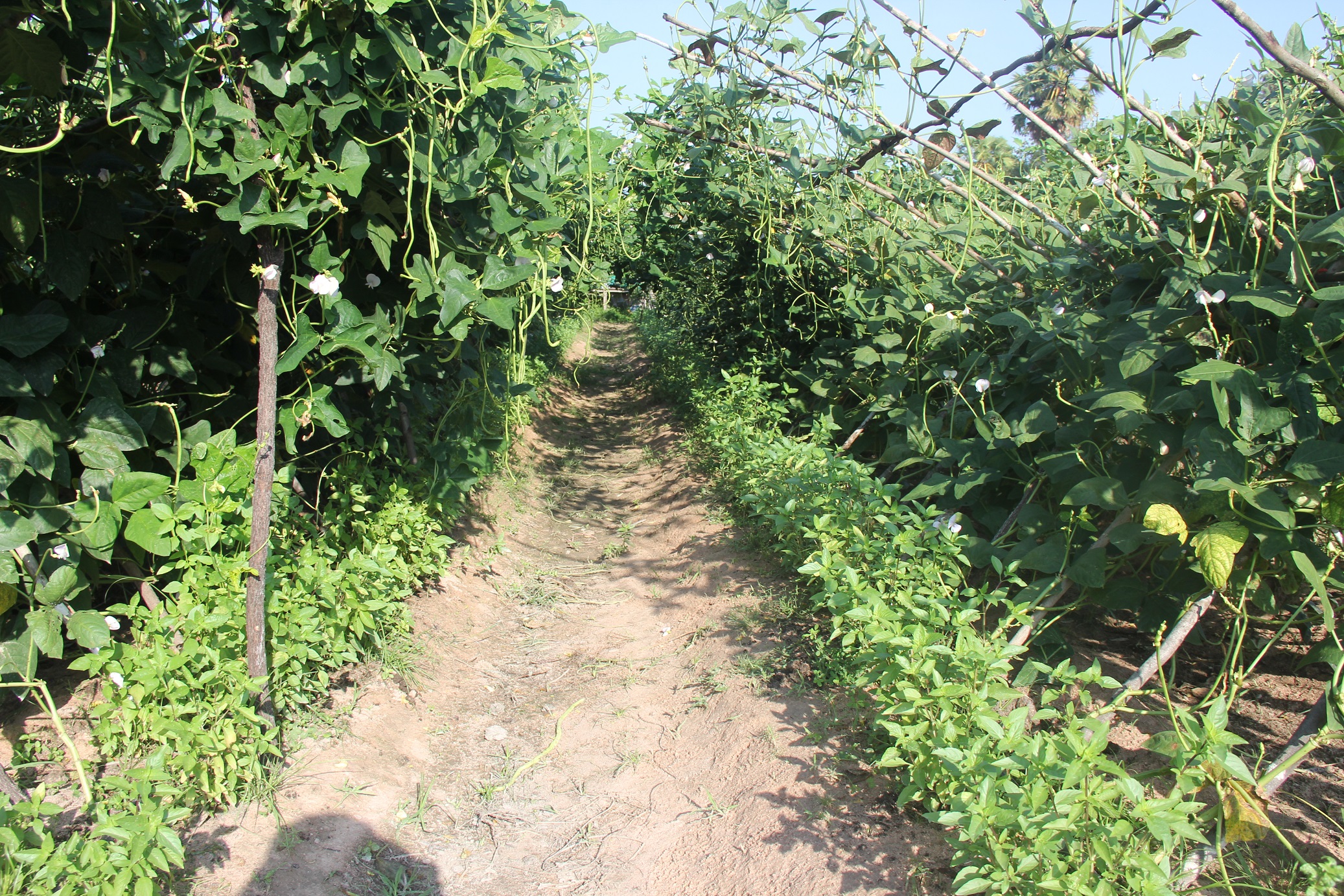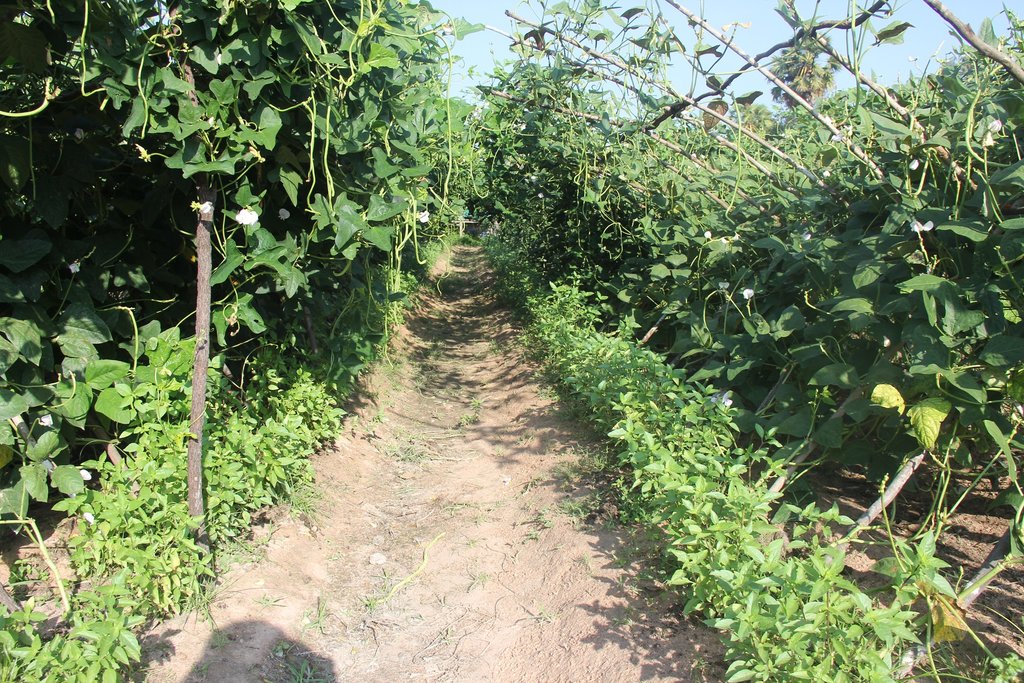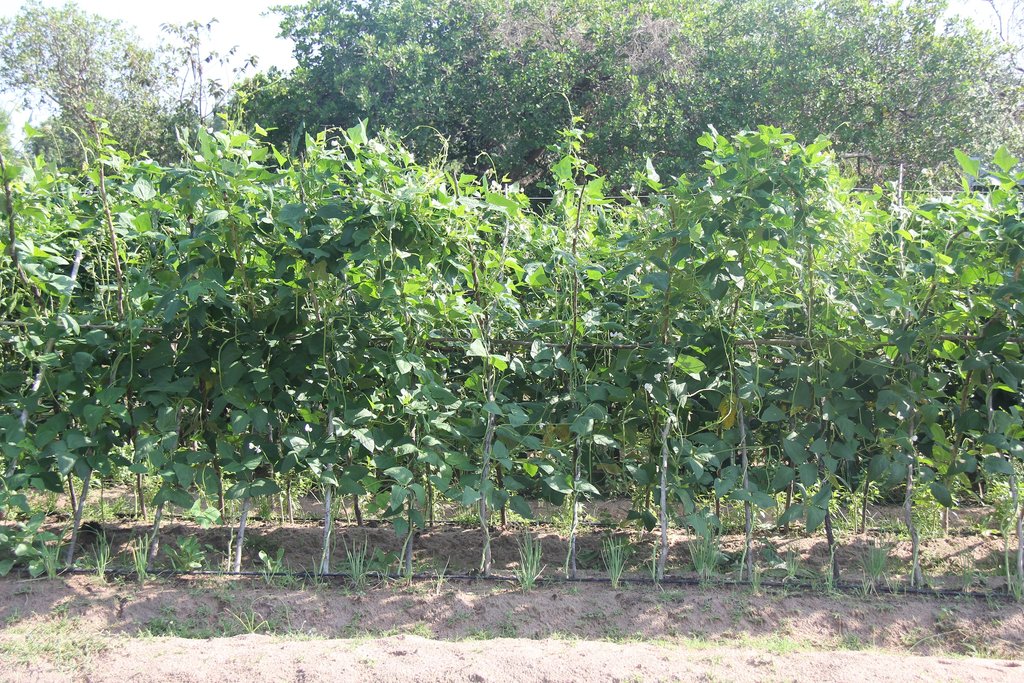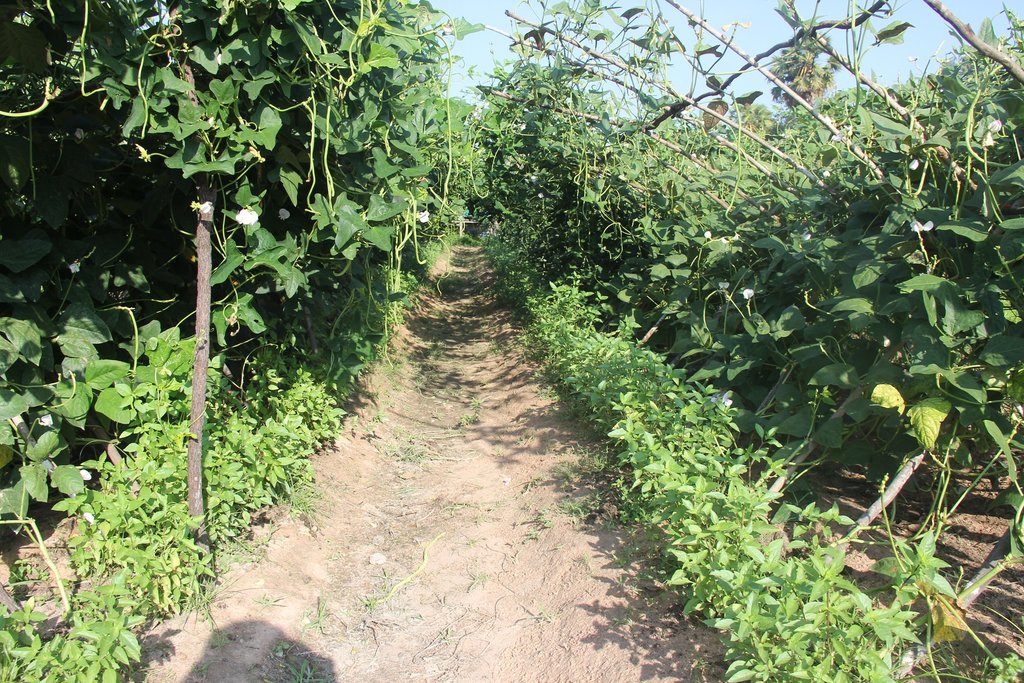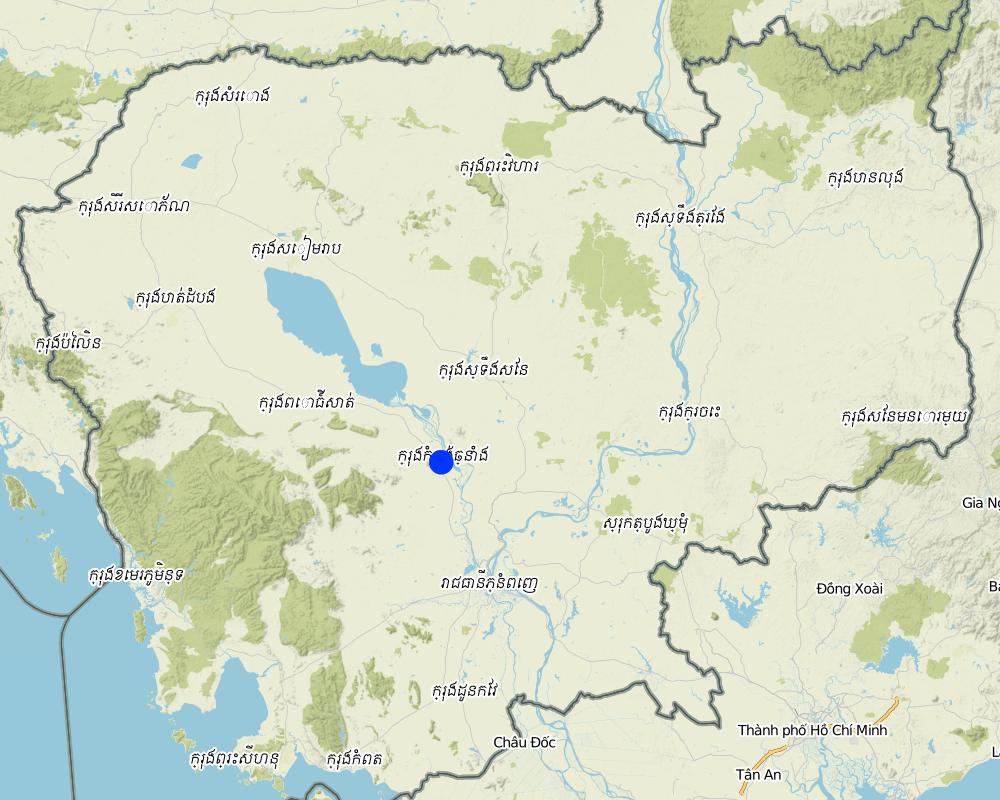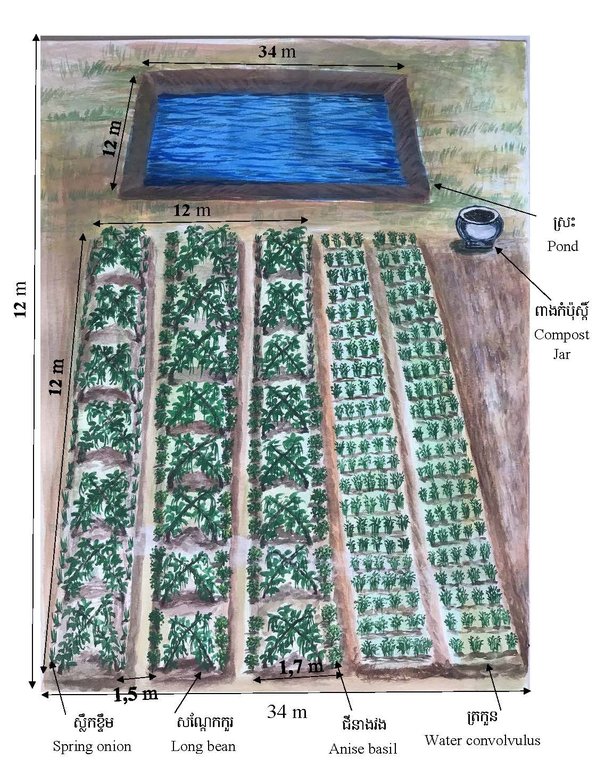ការកែប្រែគុណភាពដីខ្សាច់ដោយប្រើជីធម្មជាតិ និងជីកំប៉ុស្តិ៍ទឹក [Cambodia]
- Creation:
- Update:
- Compiler: Be Gechkim
- Editors: Navin Chea, Sophea Tim, Sok Pheak
- Reviewers: Nimul CHUN, Ursula Gaemperli
ការដាំដំណាំសណ្តែកកួរ
technologies_2949 - Cambodia
View sections
Expand all Collapse all1. General information
1.2 Contact details of resource persons and institutions involved in the assessment and documentation of the Technology
Key resource person(s)
land user:
ផល្លី ចាន់
(+855) 97 77 99 567
phallychanagronomy@yahoo.com / Fb: Phally Chan
កសិករ
ភូមិព្រៃពួច ឃុំជ្រៃបាក់ ស្រុករលាប្អៀរ ខេត្តកំពង់ឆ្នាំង។
Cambodia
អនុប្រធានផ្នែកក្សេត្រសាស្ត្រនៅការិយាល័យកសិកម្ម រុក្ខាប្រមាញ់ និងនេសាទ ស្រុករលៀប្អៀរ:
ប៊ុនលៀង ឈឹម
(+855) 96 2848278 / (+855) 87 79 73 24
chhimbunleang@gmail.com
ការិយាល័យកសិកម្មរុក្ខាប្រមាញ់ និងនេសាទស្រុករលៀប្អៀរ
ភូមិព្រៃពួច ឃុំជ្រៃបាក់ ស្រុករលៀប្អៀរ ខេត្តកំពង់ឆ្នាំង។
Cambodia
អនុប្រធានផ្នែកផ្សព្វផ្សាយកសិកម្មនៅមន្ទីរកសិកម្ម រុក្ខាប្រមាញ់ និងនេសាទ ខេត្តកំពង់ឆ្នាំង:
ប្រធានការិយាល័យកសិកម្ម រុក្ខាប្រមាញ់ និងនេសាទ ស្រុកទឹកផុស:
Name of project which facilitated the documentation/ evaluation of the Technology (if relevant)
Scaling-up SLM practices by smallholder farmers (IFAD)Name of the institution(s) which facilitated the documentation/ evaluation of the Technology (if relevant)
Royal University of Agriculture (RUA) - Cambodia1.3 Conditions regarding the use of data documented through WOCAT
When were the data compiled (in the field)?
22/05/2017
The compiler and key resource person(s) accept the conditions regarding the use of data documented through WOCAT:
Ja
1.4 Declaration on sustainability of the described Technology
Is the Technology described here problematic with regard to land degradation, so that it cannot be declared a sustainable land management technology?
Nee
Comments:
បច្ចេកទេសនេះអាចចាត់ចូលជាការគ្រប់គ្រងដីប្រកបដោយចីរភាព ព្រោះថាប្រភេទដីពីមុនស្ទើរតែជាប្រភេទដីខ្សាច់ទាំងស្រុង ដែលមិនអាចដាំដំណាំបានសូម្បីតែដំណាំត្រកួន តែក្រោយពីបានប្រើប្រាស់ជីធម្មជាតិ និងកំប៉ុស្តិ៍ទឹកមក ក៏អាចដាំដំណាំបានថែមទាំងទទួលផលល្អទៀតផង។
2. Description of the SLM Technology
2.1 Short description of the Technology
Definition of the Technology:
ការកែប្រែគុណភាពដីខ្សាច់តាមរយៈការប្រើជីធម្មជាតិ និងជីកំប៉ុស្តិ៍ទឹកដើម្បីបង្កើនផលិតកម្មដំណាំ គឺជាការផ្លាស់ប្តូរស្ថានភាពដីពីភាពហាប់ណែន ជ្រាបទឹកលឿន និងកង្វះជីជាតិមកជាដីដែលអាចរក្សាសំណើមបានយូរ និងធូរដើម្បីសម្រួលដល់ការស្រូបយកសារធាតុចិញ្ចឹមរបស់ដំណាំ។
2.2 Detailed description of the Technology
Description:
ដីខ្សាច់ជាប្រភេទដីដែលមានភាគល្អិតធំៗ មិនអាចរក្សាសំណើម និងសារធាតុចិញ្ចឹម ដែលជាហេតុធ្វើឱ្យពិបាកក្នុងការដាំដុះ។ ហេតុដូច្នេះហើយការធ្វើកសិកម្មដើម្បីកែប្រែគុណភាពដីត្រូវបានអនុវត្តដោយកសិករ ដើម្បីទទួលបាន ភាពប្រសើរឡើងនៃគុណភាពដី។ ការកែប្រែគុណភាពដី គឺជាដំណើរការបន្ថែមជីជាតិដល់ដី អាចរក្សាសំណើមបានយូរ និងដីផុសជាងមុន សម្រាប់ឱ្យដំណាំលូតលាស់បានល្អ។ ម៉្យាងវិញទៀត ដីខ្សាច់មានភាពហាប់ខ្លាំងដែលធ្វើឱ្យឬសដំណាំពិបាកក្នុងការស្រូបយកជីជាតិពីក្នុងដី។ ដើម្បីជាជំនួយក្នុងការស្រូបយកសារធាតុចិញ្ចឹម ហើយអាចបង្កើនសារធាតុចិញ្ចឹម និងសំណើមដី គេអាចបន្ថែមដីល្បប់ ឬដីភក់ និងពពួកដីដែលសម្បូរកាកសំណល់ពុកផុយទៅលើដីខ្សាច់ទាំងនោះ (Rhoades, 2016)។ ចំណែកកសិករ ក៏មានវិធីសាស្ត្រក្នុងការកែប្រែគុណភាពដីរបស់ខ្លួនឱ្យប្រសើរឡើងផងដែរ ឧទាហរណ៍ដូចជា តាមរយៈការដាំដំណាំផ្សេងៗដោយប្រើប្រាស់ជីធម្មជាតិ និងជីកំបុស្តិ៍ទឹក ជាមួយពពួកដំណាំមានក្លិនឆួល ដែលបានអនុវត្តឡើងនៅក្នុងភូមិព្រៃពួច ដែលស្ថិតក្នុងស្រុករលាប្អៀរ។
គោលបំណងនៃការអនុវត្តបច្ចេកទេសនេះរបស់គាត់ គឺធ្វើយ៉ាងណាដើម្បីធ្វើឱ្យដីខ្សាច់អាចដាំដំណាំបានផលល្អ។ បន្ទាប់ពីការប្រើប្រាស់កំប៉ុស្តិ៍ទឹក និងជីធម្មជាតិ វាជួយបង្កើនជីជាតិដី ហើយកសិករក៏បានបង្កើនប្រភេទមុខដំណាំ និងបរិមាណដំណាំ ក្រោយពេលគុណភាពដីមានភាពប្រសើរឡើងផងដែរ។ ហេតុនេះញ៉ាំងឲ្យសេដ្ឋកិច្ចគ្រួសារបានធូរធារមួយកម្រិត ព្រមទាំងមានដំណាំច្រើនប្រភេទសម្រាប់លក់ទៅតាមតម្រូវការនៅលើទីផ្សារ។
កសិករប្រើជីធម្មជាតិ ដូចជាកាកសំណល់ដំណាំ លាមកសត្វ (លាមកគោ ឬជ្រូកនៅពេលរកមិនបានលាមកគោ)។ បើទោះបីជាលាមកជ្រូកមិនបានផ្តល់សារធាតុចិញ្ចឹមដល់ដីដូចលាមកគោក៏ដោយ តែវាជួយធ្វើឱ្យដីធូរ ដែលងាយឱ្យឬសដំណាំស្រូបយកជីជាតិ និងទឹក ។ ជាងនេះទៅទៀត ដើម្បីឱ្យដីមានជីជាតិ ជីកំបុស្តិ៍ទឹកក៏ត្រូវបានប្រើប្រាស់បន្ថែម ដោយជីកំបុស្តិ៍ទឹកនេះសម្បូរពពួកមីក្រូសរីរាង្គដែលជាអ្នកបំបែកសារធាតុចិញ្ចឹមដ៏ល្អបំផុត។ កសិករបានដាំជាដំណាំសណ្តែកកួរ ឬប្រភេទដំណាំឡើងទ្រើង និងដំណាំយកស្លឹកផ្សេងៗជាលក្ខណៈវិលជុំ និងឆ្លាស់ជាមួយពពួកមានក្លិនឆួល ដូចជាស្លឹកខ្ទឹម និងជីនាងវង (ឬពពួកល្វីង ជូរ ចត់ និងក្លិនក្រពុល) នៅពីខាងក្រោមដំណាំសណ្តែកកួរ ដែលអាចការពារការរាតត្បាតពីសត្វល្អិត ដែលអាចជួយកាត់បន្ថយការប្រើប្រាស់ថ្នាំពុលគីមីបាន។ ការដាំជីនាងវង និងស្លឹកខ្ទឹម នៅលើរងចន្លោះសណ្តែកកួរ និងការដាំដំណាំឆ្លាស់នេះ គឺដើម្បីរក្សាសារធាតុចិញ្ចឹមក្នុងដីផងដែរ។
របៀបធ្វើជីកំបុស្តិ៍ទឹក៖ ត្រូវមានធាតុផ្សំសំខាន់ៗពីរមុខ គឺលាមកសត្វ (មាន់ ឬ ទា) និងស្លឹករុក្ខជាតិ (ពពួក ទន្ទ្រាងខែត្រ ស្លឹកអង្កាញ់ កន្ធំថេត អង្គារដីជាដើម)។ ដាក់ធាតុផ្សំទាំងនោះចូលក្នុងពាង ជាមួយនឹងទឹក២០ដងនៃបរិមាណធាតុផ្សំ រួចគ្របឱ្យជិតការពារការបំភាយក្លិនស្អុយ។ ត្រូវកូរឱ្យបាន ២ដងក្នុងមួយថ្ងៃដើម្បីជួយបំបែកអុកស៊ីសែនឱ្យបានដល់ពពួកមីក្រូសរីរាង្គដែលមាននៅក្នុងជី។ ក្រោយពេល ៣សប្តាហ៍ ជីកំបុស្តិ៍ទឹកនឹងលែងមានក្លិនដែលជាសញ្ញាថាអាចយកមកប្រើប្រាស់បានហើយ។ សម្រាប់ការប្រើ គឺជី ១លីត្រ ស្រោចលើផ្ទៃដី ១ម៉ែត្រការ៉េ ជាធម្មតាជីនេះអាចត្រូវបានប្រើក្នុងពេល ៣សារ នៅពេលដាំ មុនពេលចេញផ្កា និងពេលផ្លែ ឬពេលមានរោគសញ្ញាផ្សេងៗក៏បាន (Yang and Pean, 2015)។
បើប្រៀបធៀបទៅនឹងមុនពេលអនុវត្តបច្ចេកទេសនេះ កសិករមិនអាចដាំបានសូម្បីតែដំណាំត្រកួន ចំណែកឯកម្លាំងពលកម្មក៏មានតម្រូវការខ្ពស់ ហើយបរិមាណទឹកដែលត្រូវការសម្រាប់ការស្រោចស្រពក៏ច្រើនដែរ។ បច្ចេកទេសនេះជួយទាំងគុណភាពដី កាត់បន្ថយការចំណាយលើជី និងថ្នាំគីមី កម្លាំងពលកម្ម និងចំណេញផ្ទៃដីដាំ។
2.3 Photos of the Technology
2.4 Videos of the Technology
Comments, short description:
មិនមាន
Name of videographer:
មិនមាន
2.5 Country/ region/ locations where the Technology has been applied and which are covered by this assessment
Country:
Cambodia
Region/ State/ Province:
ភូមិព្រៃពួច ឃុំជ្រៃបាក់ ស្រុករលាប្អៀរ ខេត្តកំពង់ឆ្នាំង
Map
×2.6 Date of implementation
Indicate year of implementation:
2016
2.7 Introduction of the Technology
Specify how the Technology was introduced:
- through land users' innovation
Comments (type of project, etc.):
គាត់ជាអតីតមន្ត្រីផ្សព្វផ្សាយកសិកម្មដែលពេញទៅដោយបទពិសោធន៍។
3. Classification of the SLM Technology
3.1 Main purpose(s) of the Technology
- improve production
- reduce, prevent, restore land degradation
- create beneficial economic impact
3.2 Current land use type(s) where the Technology is applied

Cropland
- Annual cropping
Main crops (cash and food crops):
មានដំណាំ ៣ប្រភេទដូចជា សណ្តែកកួរ ជីនាងវង និងស្លឹកខ្ទឹម។
If land use has changed due to the implementation of the Technology, indicate land use before implementation of the Technology:
ជាប្រភេទដីស្រែ ហើយមិនសូវទទួលផលដោយសារជាប្រភេទដីខ្សាច់។
3.3 Further information about land use
Water supply for the land on which the Technology is applied:
- mixed rainfed-irrigated
Comments:
ទទួលបានទឹកស្រោចស្រពពីស្រះ និងអណ្តូងស្នប់
Number of growing seasons per year:
- 3
Specify:
សណ្តែកកួរប្រមូលផលបន្ទាប់ពីដាំបាន ៦០ទៅ៦៥ថ្ងៃ ហើយប្រមូលផលបានពី១៥ ទៅ១៨សារ ចំណែកឯជីនាងវង ២៥ ថ្ងៃ អាចប្រមូលផលបានហើយ។ ស្លឹកខ្ទឹមដាំរយៈពេល ៣០ថ្ងៃប្រមូលផលបាន ហើយប្រមូលផលបាន ១,៥ខែ (១០ទៅ២០ សារ)។
3.4 SLM group to which the Technology belongs
- rotational systems (crop rotation, fallows, shifting cultivation)
- integrated soil fertility management
- integrated pest and disease management (incl. organic agriculture)
3.5 Spread of the Technology
Specify the spread of the Technology:
- evenly spread over an area
Comments:
អនុវត្តត្រឹមទំហំទទឹង ១២ ម៉ែត្រ និងបណ្តោយ ៣០ ម៉ែត្រ
3.6 SLM measures comprising the Technology

agronomic measures
- A1: Vegetation/ soil cover
- A2: Organic matter/ soil fertility

structural measures
- S7: Water harvesting/ supply/ irrigation equipment
3.7 Main types of land degradation addressed by the Technology

chemical soil deterioration
- Cn: fertility decline and reduced organic matter content (not caused by erosion)

water degradation
- Ha: aridification
3.8 Prevention, reduction, or restoration of land degradation
Specify the goal of the Technology with regard to land degradation:
- restore/ rehabilitate severely degraded land
Comments:
ដោយប្រើប្រាស់ជីកំប៉ុស្តិ៍ លាមកគោ មាន់ ជ្រូក និងលាយជាមួយដីដំបូកសម្រាប់ដាំដំណាំដើម្បីកែប្រែគុណភាពដី។
4. Technical specifications, implementation activities, inputs, and costs
4.1 Technical drawing of the Technology
4.2 Technical specifications/ explanations of technical drawing
បច្ចេកទេសនេះត្រូវបានអនុវត្តនៅលើផ្ទៃដីដែលមានបណ្តោយ ៥២ម៉ែត្រ និងទទឹង ៣៤ម៉ែត្រ ដែលមានស្រះទឹកមួយនៅខាងក្រោយមានទទឹង ២២ម៉ែត្រ បណ្តោយ ៣៤ម៉ែត្រ និងជម្រៅ ៥ម៉ែត្រ។ នៅក្នុងទំហំដីសល់ពីស្រះជាដីដាំសណ្តែកកួរដែលមានបណ្តោយ ៣០ម៉ែត្រ និងទទឹង ១២ម៉ែត្រ។ រងសណ្តែកនោះមានទទឹង ១,៧ម៉ែត្រ ចន្លោះរង ១,៥ម៉ែត្រ កម្ពស់រង ៣០សង់ទីម៉ែត្រ ហើយចន្លោះគុម្ព ៤០សង់ទីម៉ែត្រ។ ផ្ទៃដីដាំសណ្តែកកួរនេះមានសណ្តែកកួរចំនួន ៣រង ត្រូវជា ៦ជួរ ក្នុងជួរនីមួយៗមានចន្លោះប្រវែង ៤០សង់ទីម៉ែត្រ និងមានដាំជីនាងវង និងស្លឹកខ្ទឹមនៅចន្លោះគុម្ពសណ្តែកកួរទាំងនោះ។ របៀបធ្វើជីកំបុស្តិ៍ទឹក៖ ត្រូវមានធាតុផ្សំសំខាន់ៗពីរមុខ គឺលាមកសត្វ (មាន់ ឬ ទា) និង ស្លឹករុក្ខជាតិ (ពពួក ទន្រ្ទាងខែត្រ ស្លឹកអង្កាញ់ កន្ធំថេត អង្គារដីជាដើម)។ ដាក់ធាតុផ្សំទាំងនោះចូលក្នុងពាង ជាមួយនឹងទឹក ២០ដងនៃបរិមាណធាតុផ្សំ រួចគ្របឱ្យជិតការពារការបំភាយក្លិនស្អុយ។ ត្រូវកូរឱ្យបាន ២ដងក្នុងមួយថ្ងៃដើម្បីជួយបំបែកអុកស៊ីសែនឱ្យបានដល់ពពួកមីក្រូសរីរាង្គដែលមាននៅក្នុងជី។ ក្រោយពេល ៣សប្តាហ៍ ជីកំបុស្តិ៍ទឹកនឹងលែងមានក្លិនដែលជាសញ្ញាថាអាចយកមកប្រើប្រាស់បានហើយ។ សម្រាប់ការប្រើ គឺជី ១លីត្រ ស្រោចលើផ្ទៃដី ១ម៉ែត្រការ៉េ ជាធម្មតាជីនេះអាចត្រូវបានប្រើក្នុងពេល ៣សារ នៅពេលដាំ មុនពេលចេញផ្កា និងពេលផ្លែ ឬពេលមានរោគសញ្ញាផ្សេងៗក៏បាន។
4.3 General information regarding the calculation of inputs and costs
Specify how costs and inputs were calculated:
- per Technology area
Indicate size and area unit:
១២ X ៣០ = ៣៦០ ម៉ែត្រការ៉េ
other/ national currency (specify):
រៀល
Indicate exchange rate from USD to local currency (if relevant): 1 USD =:
4000.0
Indicate average wage cost of hired labour per day:
25000 រៀល
4.4 Establishment activities
| Activity | Type of measure | Timing | |
|---|---|---|---|
| 1. | ភ្ជួរដីហាល | Agronomic | ខែឧសភា |
| 2. | បាចកំបោរ | Agronomic | ខែឧសភា |
| 3. | លើករង | Structural | ខែឧសភា |
| 4. | ដាក់លាមកគោ និងដីដំបូក | Agronomic | ខែឧសភា |
| 5. | ការរៀបប្រព័ន្ធតំណក់ទឹក | Structural | ខែឧសភា |
| 6. | លើកទ្រើង | Structural | ខែឧសភា |
| 7. | បណ្តុះកូន | Agronomic | ខែឧសភា |
4.5 Costs and inputs needed for establishment
If possible, break down the costs of establishment according to the following table, specifying inputs and costs per input. If you are unable to break down the costs, give an estimation of the total costs of establishing the Technology:
3600000.0
| Specify input | Unit | Quantity | Costs per Unit | Total costs per input | % of costs borne by land users | |
|---|---|---|---|---|---|---|
| Labour | ភ្ជួរដីហាល | សារ | 3.0 | 20000.0 | 60000.0 | 100.0 |
| Labour | លើករងនិងបាចកំបោរ | ថ្ងៃ | 2.0 | 25000.0 | 50000.0 | 100.0 |
| Labour | រៀបប្រព័ន្ធតំណក់ទឹក | ថ្ងៃ | 1.0 | 25000.0 | 25000.0 | 100.0 |
| Equipment | ចបជីក | ចប | 1.0 | 15000.0 | 15000.0 | 100.0 |
| Equipment | ចបកាប់ | ចប | 1.0 | 20000.0 | 20000.0 | 100.0 |
| Equipment | ប៊ែល | ប៊ែល | 1.0 | 20000.0 | 20000.0 | 100.0 |
| Plant material | គ្រាប់ពូជសណ្តែកកួរ | កញ្ចប់ | 1.0 | 10000.0 | 10000.0 | 100.0 |
| Plant material | ស្លឹកខ្ទឹម | គីឡូក្រាម | 3.0 | 4000.0 | 12000.0 | 100.0 |
| Plant material | ថាសបណ្តុះកូន | ថាស | 6.0 | 4000.0 | 24000.0 | 100.0 |
| Fertilizers and biocides | លាមកគោ | រទេះ | 6.0 | 20000.0 | 120000.0 | 100.0 |
| Fertilizers and biocides | ជី DAP | គីឡូក្រាម | 5.0 | 3000.0 | 15000.0 | 100.0 |
| Fertilizers and biocides | ជី KCL | គីឡូក្រាម | 5.0 | 3000.0 | 15000.0 | 100.0 |
| Fertilizers and biocides | ជីអ៊ុយរ៉េ | គីឡូក្រាម | 5.0 | 3500.0 | 17500.0 | 100.0 |
| Construction material | ប្រព័ន្ធតំណក់ទឹក | ឈុត | 1.0 | 110000.0 | 110000.0 | 100.0 |
| Construction material | បំពង់ទីប | ដើម | 2.0 | 20000.0 | 40000.0 | 100.0 |
| Construction material | មែកឈើសម្រាប់ធ្វើទ្រើង | ដើម | 225.0 | 300.0 | 67500.0 | 100.0 |
| Construction material | ធុងទឹក | ធុង | 2.0 | 6000.0 | 12000.0 | 100.0 |
| Total costs for establishment of the Technology | 633000.0 | |||||
4.6 Maintenance/ recurrent activities
| Activity | Type of measure | Timing/ frequency | |
|---|---|---|---|
| 1. | ធ្វើស្មៅ | Agronomic | រាល់២ សប្តាហ៍ម្តង |
| 2. | ជ្រោយជើងដាក់លាមកគោ និងជីកំប៉ុស្តិ៍ | Agronomic | ១វដ្ដដំណាំម្ដងពេលដំណាំអាយុ ១០ ទៅ ១៥ថ្ងៃ |
| 3. | កាត់ខ្នែងក្រោម | Agronomic | នៅអាយុ ២០ ទៅ ២៥ថ្ងៃ |
| 4. | ដាក់ DAP, KCL | Agronomic | ដាក់ ៣ដង នៅពេលដាំ ពេលចេញផ្កា និងផ្លែ |
| 5. | ធ្វើថ្នាំសម្លាប់សត្វល្អិត និងបាញ់ | Agronomic | ធ្វើនៅពេលមានសត្វល្អិតបំផ្លាញ |
| 6. | បាញ់ថ្នាំសត្វល្អិត (ស្រឹង ចៃ ស្រាំងទិច) | Agronomic | បាញ់ថ្នាំនៅពេលមានសត្វល្អិតបំផ្លាញ |
Comments:
ក្នុងការធ្វើថ្នាំសម្លាប់សត្វល្អិត កសិករប្រើសាប៊ូ ៣ក្រាម ប្រេងឆា ៣ស្លាបព្រា ម្ទេស ៣ ទៅ ៤ គ្រាប់ ជាមួយទឹក ១លីត្រ។
4.7 Costs and inputs needed for maintenance/ recurrent activities (per year)
If possible, break down the costs of maintenance according to the following table, specifying inputs and costs per input. If you are unable to break down the costs, give an estimation of the total costs of maintaining the Technology:
400000.0
4.8 Most important factors affecting the costs
Describe the most determinate factors affecting the costs:
ការរៀបចំប្រព័ន្ធស្រោចស្រព (តំណក់ទឹក)
5. Natural and human environment
5.1 Climate
Annual rainfall
- < 250 mm
- 251-500 mm
- 501-750 mm
- 751-1,000 mm
- 1,001-1,500 mm
- 1,501-2,000 mm
- 2,001-3,000 mm
- 3,001-4,000 mm
- > 4,000 mm
Specify average annual rainfall (if known), in mm:
1209.00
Specifications/ comments on rainfall:
បរិមាណទឹកភ្លៀងប្រចាំឆ្នាំ ២០១៥ មានចំនួន ១២០៩ មម ឆ្នាំ ២០១៤ មានចំនួន ១៤២០.៧៤ មម និងឆ្នាំ ២០១៣ មានចំនួន ១៣៦៧.៥ មម។
Indicate the name of the reference meteorological station considered:
ក្រសួងធនធានទឹក និងឧតុនិយម (២០១៥)
Agro-climatic zone
- semi-arid
5.2 Topography
Slopes on average:
- flat (0-2%)
- gentle (3-5%)
- moderate (6-10%)
- rolling (11-15%)
- hilly (16-30%)
- steep (31-60%)
- very steep (>60%)
Landforms:
- plateau/plains
- ridges
- mountain slopes
- hill slopes
- footslopes
- valley floors
Altitudinal zone:
- 0-100 m a.s.l.
- 101-500 m a.s.l.
- 501-1,000 m a.s.l.
- 1,001-1,500 m a.s.l.
- 1,501-2,000 m a.s.l.
- 2,001-2,500 m a.s.l.
- 2,501-3,000 m a.s.l.
- 3,001-4,000 m a.s.l.
- > 4,000 m a.s.l.
Indicate if the Technology is specifically applied in:
- not relevant
5.3 Soils
Soil depth on average:
- very shallow (0-20 cm)
- shallow (21-50 cm)
- moderately deep (51-80 cm)
- deep (81-120 cm)
- very deep (> 120 cm)
Soil texture (topsoil):
- medium (loamy, silty)
Soil texture (> 20 cm below surface):
- coarse/ light (sandy)
Topsoil organic matter:
- medium (1-3%)
If available, attach full soil description or specify the available information, e.g. soil type, soil PH/ acidity, Cation Exchange Capacity, nitrogen, salinity etc.
pH=៦,៥ និងជាប្រភេទដីខ្សាច់រហូតដល់ជម្រៅ ២ម៉ែត្រ ប៉ុន្តែបច្ចុប្បន្នដីស្រទាប់លើប្រសើរជាងមុន។
5.4 Water availability and quality
Ground water table:
5-50 m
Availability of surface water:
good
Water quality (untreated):
good drinking water
Is water salinity a problem?
Nee
Is flooding of the area occurring?
Nee
5.5 Biodiversity
Comments and further specifications on biodiversity:
មិនទាក់ទង
5.6 Characteristics of land users applying the Technology
Sedentary or nomadic:
- Sedentary
Market orientation of production system:
- mixed (subsistence/ commercial
Off-farm income:
- 10-50% of all income
Relative level of wealth:
- rich
Individuals or groups:
- individual/ household
Level of mechanization:
- manual work
Gender:
- men
Age of land users:
- elderly
Indicate other relevant characteristics of the land users:
គាត់មានអាយុប្រមាណ 54 ឆ្នាំ។
5.7 Average area of land owned or leased by land users applying the Technology
- < 0.5 ha
- 0.5-1 ha
- 1-2 ha
- 2-5 ha
- 5-15 ha
- 15-50 ha
- 50-100 ha
- 100-500 ha
- 500-1,000 ha
- 1,000-10,000 ha
- > 10,000 ha
Is this considered small-, medium- or large-scale (referring to local context)?
- small-scale
Comments:
ដីដាំដំណាំសរុប 70អា ដីស្រែ 3អា និងដីព្រៃ 2អា។
5.8 Land ownership, land use rights, and water use rights
Land ownership:
- individual, titled
Land use rights:
- individual
Water use rights:
- individual
5.9 Access to services and infrastructure
health:
- poor
- moderate
- good
education:
- poor
- moderate
- good
technical assistance:
- poor
- moderate
- good
employment (e.g. off-farm):
- poor
- moderate
- good
markets:
- poor
- moderate
- good
energy:
- poor
- moderate
- good
roads and transport:
- poor
- moderate
- good
drinking water and sanitation:
- poor
- moderate
- good
financial services:
- poor
- moderate
- good
6. Impacts and concluding statements
6.1 On-site impacts the Technology has shown
Socio-economic impacts
Production
crop production
Comments/ specify:
ប្រើលាមកសត្វ និងជីកំប៉ុស្តិ៍ទឹក
risk of production failure
product diversity
Income and costs
farm income
Comments/ specify:
ដីផុស និងមានជីជាតិដែលធ្វើឱ្យដំណាំទទួលបានទិន្នផលកើនឡើង។
diversity of income sources
Comments/ specify:
ដាំដំណាំច្រើនមុខដែលបង្កើនប្រភពចំណូលច្រើនដែរ។
economic disparities
Comments/ specify:
កាលពីមុនកសិករមានជីវភាពលំបាកដោយសារគាត់ដីរបស់គាត់ជាប្រភេទដីខ្សាច់មិនអាចដាំដុះបាន។ ការបង្កើនជីជាតិដីនេះក៏បានជួយបង្កើនជីវភាពគ្រួសាររបស់គាត់ដែរ។
workload
Comments/ specify:
សម្រួលបន្ទុកការងារដោយប្រើប្រាស់ប្រព័ន្ធតំណក់ទឹក និងការដាំជីជួយកាត់បន្ថយស្មៅនិងសត្វល្អិត។
Socio-cultural impacts
food security/ self-sufficiency
Comments/ specify:
ទទួលបានបន្លែស្រស់ៗ និងមានចំណូលជាប្រចាំ
health situation
Comments/ specify:
មិនដែលមានបញ្ហាសុខភាពឡើយ
land use/ water rights
Comments/ specify:
មានអណ្ដូងទឹកសម្រាប់ប្រើប្រាស់តាំងពីមុន
recreational opportunities
Comments/ specify:
ក្រោយពីឈប់ពីការងាររដ្ឋត្រលប់មកធ្វើកសិកម្មវិញកុំអោយទំនេរនិងជាលំហាត់ប្រាណផង។
SLM/ land degradation knowledge
Ecological impacts
Water cycle/ runoff
water quantity
Comments/ specify:
បើទោះជាមានការដាំដំណាំច្រើនប្រភេទក៏ដោយតែបរិមាណទឹកមិនមានកង្វះខាតសម្រាប់ប្រើប្រាស់ឡើយ។
water quality
Comments/ specify:
មិនប្រើប្រាស់ជីគីមីដែលធ្វើឱ្យប៉ះពាល់ដល់គុណភាពទឹកនោះទេ។
excess water drainage
Comments/ specify:
ប្រើប្រាស់ប្រព័ន្ធតំណក់ទឹក
Soil
soil moisture
Comments/ specify:
ដាំដំណាំច្រើនធ្វើជាគម្របដីដែលជួយបង្កើនសំណើមដី។ ម៉្យាងទៀតលាមកសត្វក៏បានជួយបង្កើនជីជាតិដីផងដែរ។
soil cover
Comments/ specify:
មិនទុកដីឱ្យទំនេរដូចមុន
soil compaction
Comments/ specify:
ដីធូរជាងមុនដោយប្រើលាមកសត្វ និងកំប៉ុស្តិ៍ ហើយវាក៏ជួយឱ្យប្រសើរឡើងនូវទម្រង់ដី។
nutrient cycling/ recharge
Comments/ specify:
ប្រើលាមកសត្វ និងកំប៉ុស្តិ៍
soil organic matter/ below ground C
Comments/ specify:
ប្រើលាមកសត្វ និងកំប៉ុស្តិ៍រាល់ពេលដាំ
Biodiversity: vegetation, animals
Vegetation cover
Comments/ specify:
កាលពីមុនដាំតែត្រកួនមិនបានទទួលផលផង តែឥលូវដាំដំណាំបានច្រើនមុខដែលជួយកាត់បន្ថយការហូរច្រោះដីទៀតផង។
plant diversity
Comments/ specify:
ដាំដំណាំច្រើនមុខ និងផ្លាស់ប្ដូរប្រភេទដំណាំ
invasive alien species
Comments/ specify:
ដោយប្រើការដាំជីដែលជាពពួកមានក្លិន តែវាជួយកាត់បន្ថយបានតិចតួចប៉ុណ្ណោះ។
beneficial species
Comments/ specify:
ឃើញសម្បូរជន្លេនជាងមុន
pest/ disease control
Comments/ specify:
កាត់បន្ថយបានខ្លះប៉ុណ្ណោះដោយមានដាំពពួកមានក្លិនឆួលពីក្រោម។
6.2 Off-site impacts the Technology has shown
Comments regarding impact assessment:
មិនមានជាបញ្ហាផ្សេងៗទៅដល់បរិវេណក្រៅបច្ចេកទេសនោះទេ។
6.3 Exposure and sensitivity of the Technology to gradual climate change and climate-related extremes/ disasters (as perceived by land users)
Gradual climate change
Gradual climate change
| Season | Type of climatic change/ extreme | How does the Technology cope with it? | |
|---|---|---|---|
| annual temperature | increase | well | |
| annual rainfall | not known |
Climate-related extremes (disasters)
Climatological disasters
| How does the Technology cope with it? | |
|---|---|
| heatwave | well |
Biological disasters
| How does the Technology cope with it? | |
|---|---|
| epidemic diseases | well |
Comments:
មានការផ្លាស់ប្ដូរដំណាំតាមភាពធន់របស់ដំណាំទៅនឹងកំណើនកម្ដៅ។
6.4 Cost-benefit analysis
How do the benefits compare with the establishment costs (from land users’ perspective)?
Short-term returns:
slightly positive
Long-term returns:
positive
How do the benefits compare with the maintenance/ recurrent costs (from land users' perspective)?
Short-term returns:
positive
Long-term returns:
positive
6.5 Adoption of the Technology
- single cases/ experimental
Of all those who have adopted the Technology, how many have did so spontaneously, i.e. without receiving any material incentives/ payments?
- 90-100%
Comments:
នៅក្នុងភូមិមានតែផ្ទះកសិកររូបនេះប៉ុណ្ណោះដែលធ្វើកសិកម្មបែបនេះ ក្រៅពីនោះមិនមានអ្នកចាប់អារម្មណ៍ឡើយ។
6.6 Adaptation
Has the Technology been modified recently to adapt to changing conditions?
Nee
6.7 Strengths/ advantages/ opportunities of the Technology
| Strengths/ advantages/ opportunities in the land user’s view |
|---|
| បង្កើនប្រាក់ចំណូលក្នុងគ្រួសារ |
| មិនប៉ះពាល់ដល់សុខភាពដោយមិនប្រើជី ឬថ្នាំគីមី |
| ជួយកាត់បន្ថយការនាំដំណាំចូលពីក្រៅ |
| Strengths/ advantages/ opportunities in the compiler’s or other key resource person’s view |
|---|
| អាចជួយកាត់បន្ថយសត្វល្អិតមួយចំនួនដោយមានដាំពពួកមានក្លិនដូចជាជី និងខ្ទឹម |
| បង្កើនជីជាតិដី និងរក្សាគុណភាពដីដោយផ្លាស់ប្តូរដំណាំ និងប្រើប្រាស់លាមកសត្វ និងជីកំប៉ុស្តិ៍ |
| ទទួលបានចំណូលបន្ថែម និងស្រួលលក់ |
6.8 Weaknesses/ disadvantages/ risks of the Technology and ways of overcoming them
| Weaknesses/ disadvantages/ risks in the land user’s view | How can they be overcome? |
|---|---|
| នៅមានពពួកសត្វល្អិតមួយចំនួនទៀត | ប្រើប្រាស់ថ្នាំសំលាប់សត្វល្អិតដែលផលិតដោយកសិករផ្សំពីរុក្ខជាតិ។ |
7. References and links
7.1 Methods/ sources of information
- field visits, field surveys
១កន្លែង
- interviews with land users
១នាក់
- interviews with SLM specialists/ experts
៣នាក់
7.2 References to available publications
Title, author, year, ISBN:
Yang S. and Pean S. (2015) Kit of Simple Agriculture Technologies. CEDAC. (In Khmer)
Available from where? Costs?
Can find out at CEDAC, cost 10000 Riel
7.3 Links to relevant information which is available online
Title/ description:
Rhoades H. (2016) Sandy Soil Amendments: How to do sandy soil improvement. Gardening.
URL:
Retrieved on July 18 from: https://www.gardeningknowhow.com/garden-how-to/soil-fertilizers/amending-sandy-soil.htm
Links and modules
Expand all Collapse allLinks
No links
Modules
No modules


